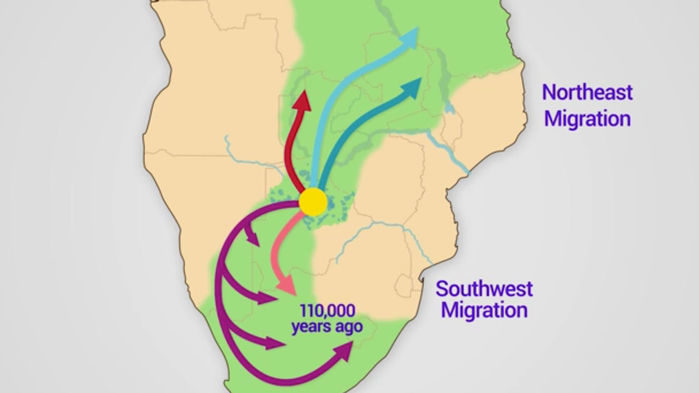
A new genetic study suggests all modern humans trace our ancestry to a single spot in southern Africa 200,000 years ago. But experts say the study, which analyzes the DNA of living people, is not nearly comprehensive enough to pinpoint where our species arose.
"I'm persuaded that southern Africa was an important area for human evolution," says population geneticist Aylwyn Scally of the University of Cambridge in the United Kingdom who was not involved with the work. But, he says, studies of living people's DNA can't reveal the precise location of our ancestors. "It would be astonishing if all our genetic ancestry at this time arose in one small homeland."
Modern humans arose in Africa at least 250,000 to 300,000 years ago, fossils and DNA reveal. But scientists have been unable to pinpoint a more specific homeland because the earliest Homo sapiens fossils are found across Africa, and ancient DNA from African fossils is scarce and not old enough.
Comment: Which shows that this particular group were already well dispersed throughout Africa.
In the new study, researchers gathered blood samples from 200 living people in groups whose DNA is poorly known, including foragers and hunter-gatherers in Namibia and South Africa who speak Khoisan languages with click consonants. The authors analyzed the mitochondrial DNA (mtDNA), a type of DNA inherited only from mothers, and compared it to mtDNA in databases from more than 1000 other Africans, mostly from southern Africa. Then the researchers sorted how all the samples were related to each other on a family tree.
Comment: Doesn't this just prove that these Africans share ancestry with the other Africans sampled?
Confirming earlier studies, the data reveal that one mtDNA lineage in the Khoisan speakers — L0 — is the oldest known mtDNA lineage in living people. The work also tightens the date of origin of L0 to about 200,000 years ago (with a range of error of 165,000 to 240,000; previous studies had a range of error from 150,000 to 250,000), the team reports today in Nature. Because today this lineage is found only in people in southern Africa, people carrying the L0 lineage lived in southern Africa and formed the ancestral population for all living humans, says lead author Vanessa Hayes, a genomicist at the Garvan Institute of Medical Research and the University of Sydney in Australia.
Specifically, Hayes and her colleagues argue that the homeland was in what is now the Kalahari region of northern Botswana. Although the Kalahari is mostly desert and salt flats today, it was a lush wetland from 200,000 to 130,000 years ago near what would have been the largest lake in Africa, according to climate data and simulations in the study.
The team proposes that people with the L0 mtDNA thrived in their Kalahari homeland until about 130,000 to 110,000 years ago, when climate change opened green corridors to the northeast and southwest. Some individuals left their homeland and evolved new mtDNA lineages that the team identifies.
Comment: Do the authors know how or why mtDNA just suddenly 'evolves'? Isn't that a critical understanding necessary for their argument?
But mtDNA alone in living people is a poor tool for tracking ancient population history in Africa, says evolutionary geneticist Sarah Tishkoff of the University of Pennsylvania. MtDNA traces only one genetic lineage passed from mothers to their children over time. If the researchers had traced the evolution of Y chromosomes inherited from fathers or of any nuclear genes inherited from both parents, they might have gotten many different answers, Scally adds.
Hayes responds that the team chose mtDNA because it doesn't get shuffled in early fetal development like other types of DNA do. As a result, it can be used to trace living people's evolution in a direct line to a small number of female ancestors who only lived in southern Africa, she says. "It acts like a time capsule for our ancestral mothers." Most of the data on Khoisan speakers' Y chromosomes has disappeared as men mixed with other groups, she says.
Critics also warn that the female ancestors of the Khoisan speakers may not have lived in the same place 200,000 years ago. The ancestral women with the L0 lineage could have migrated to southern Africa from elsewhere or been part of a larger population whose descendants outside of southern Africa went extinct, Tishkoff says.
The bottom line, says population geneticist Pontus Skoglund of the Francis Crick Institute in London, is that populations move and mix so much over the millennia that studying DNA from living humans is "very limited when it comes to reconstructing what happened to populations 70,000 to 200,000 years ago." For that, he says, you need ancient DNA. Or well-dated fossils.
doi:10.1126/science.aba0155
Ann Gibbons is a contributing correspondent for Science. Twitter



Comment: In recent years the Out of Africa hypothesis has been well and truly debunked, and this study proves just how weak some of the arguments are:
- 700,000 years old skull discovered in Greek cave in 1959 shatters Out of Africa theory
- Rethinking Out of Africa: New study suggests ancient hominins in Asia 500k earlier than previously thought
- The mysterious relationship between the boab tree of Australia and the Baobab tree of Africa
- Out of Europe rather than out of Africa, new study suggest
For more check out SOTT radio's: